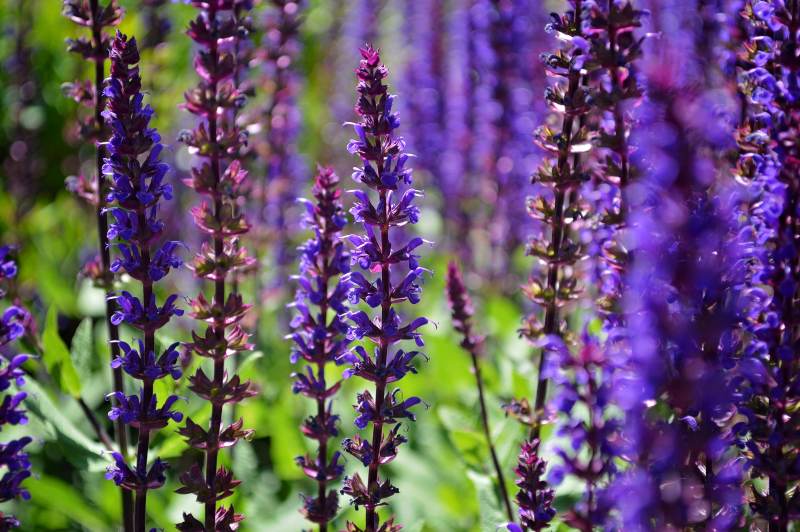Salvias are a popular group of plants, grown for their showy flowers and attractive foliage. However, they can be susceptible to a number of problems, which can detract from their appearance or even kill the plant.
In this article, we will discuss 10 of the most common problems with salvias, including issues with leaves, flowers, and stems. I will also provide some tips on how to prevent or solve these salvia problems so you can enjoy these beauties thriving.
10 Common Problems With Salvias
1. Yellowing leaves
One of the most common problems with salvias is yellowing leaves. This can be caused by a number of factors, including nutrient deficiency, pests, or disease.
If you notice that your plant’s leaves are starting to turn yellow, check for other signs of stress, such as wilting or leaf drop. If you see these other symptoms, it’s likely that the yellowing leaves are due to a nutrient deficiency. The best way to solve this problem is to fertilize your plant with a balanced fertilizer.
If there are no other signs of stress, then the yellowing leaves may be caused by pests or disease. If you see any insects on the plant, try to remove them with a soft cloth or brush. You can also use an insecticide to get rid of pests. If you suspect that your plant has a disease, you should consult with a local nursery or gardening center for advice on how to treat it.
2. Wilting leaves
Wilting leaves are another common problem with salvias. The most common causes are drought, heat stress, or nutrient deficiency.
If you spot that your salvia’s leaves are wilting, check the soil to see if it is dry. If the soil is dry, water your plant deeply and evenly. If the soil is moist, check for other signs that show that your plant is struggling, such as yellowing leaves or leaf drop. If you notice these other symptoms, it’s possible that the wilting leaves are due to a nutrient deficiency. That’s where a good fertilizer comes in handy.
If the wilting leaves are the only symptom you see, then the plant may be experiencing heat stress. This is common in hot weather when the plant is not getting enough water. If the weather is hot and dry, make sure to water your plant regularly. You can also try to provide some shade for your plant if it is in a sunny spot. If the wilting leaves are due to heat stress, your salvia should recover once the weather cools down.

3. Leaf drop
Sometimes, you may notice that your salvia is losing its leaves. The most common causes of leaf drop are drought, heat stress, or nutrient deficiency.
The first thing you should do if you notice a leaf drop is to inspect the soil. If the soil is dry, give your saliva plant a good watering. If the soil is moist, check for other signs of stress, such as wilting leaves or yellowing leaves. If you see these other symptoms, your plant might be suffering from a nutrient deficiency. The best way to solve this problem is to fertilize your plant with a balanced fertilizer.
There are no other problems with your salvia other than leaves dropping? It might be that your salvia is under heat stress. You might notice that the leaf drop is more common during hot weather. If this is the case, try to provide some shade for your plant and make sure to water it plenty.
4. Stem dieback
Now that we’ve covered the most common problems with saliva leaves, let’s move on to stem dieback. This is when the stems of your plant start to turn brown and die.
The most common cause of stem dieback is due to the plant not getting enough water. First things first, check the soil to see if it is dry. If it is, water your plant generously and keep an eye on it to make sure that the soil doesn’t dry out again.
If the problem persists, it might be due to a disease or pest infestation. If you see any signs of pests, such as insects or caterpillars, first try to get rid of them with a soft cloth or brush and consider using an insecticide. If you think that your plant might have a disease, it’s best to consult with a local nursery or gardening center – they should be knowledgeable about the most common problems with salvias in your climate zone.
5. Slow growth
Salvias are typically fast-growing plants, that are easy to care for. Depending on the variety of Salvia you have, from sprouting to full growth it normally takes around 3-5 months. If your Salvia is taking longer than usual to grow, there are a few possible explanations.
One reason could be that it is not receiving enough sunlight. Salvias love the full sun and need around 6 hours of direct sunlight per day in order to thrive. If your plant is not getting enough sunlight, try replanting or moving it to a sunnier spot.
Another possibility is that the plant is not getting enough water. Salvias are drought-tolerant, but they still need to be watered regularly in order to grow well. If you experience dry spells or hot weather, make sure to water your plants regularly.
Finally, another possibility is that the plant is experiencing a nutrient deficiency. In that case, it’s worth trying out a fertilizer to give your salvia a boost.
6. Powdery mildew

Powdery mildew is a type of fungus that loves salvias (and many other types of plants). Luckily it’s easy to spot – it appears as a white, powdery substance on the leaves and stems of the plant.
Powdery mildew is more common in humid or wet conditions. If your plant is affected by powdery mildew, try to increase air circulation around it by pruning the plant or moving it to a more open area. Also, try to improve drainage and make sure that the plant isn’t getting too much water.
If the problem persists, you can also try using a fungicide to get rid of the powdery mildew.
7. Pests
Pests are one of the most common problems with salvias. The most likely pests invading your salvias are aphids, whiteflies, and caterpillars. These pests can cause leaf damage, stunt growth, and even kill your plant if they are not controlled.
The best way to control pests is to prevent them from infesting your plant in the first place. This can be done by keeping your garden clean and free of debris, as well as by regularly inspecting your plants for signs of pests.
If you do find pests on your plant, the best thing to do is to remove them by hand or with a soft brush. Then, you might need to use insecticide to get rid of them completely.
8. Not flowering

Salvias have beautiful flowers that come in a variety of colors, including white, pink, purple, and blue. However, a common question when growing Salvias is “Why my salvia is not blooming?“. There are a few possible reasons.
Firstly, it could be that the plant is not getting enough sunlight. Salvias need full sun in order to flower well, so if your plant is in a shady spot, it might not flower as much as you would like.
Another possibility is that the plant is too young. Salvias typically start flowering when they are around 3-5 months old, so if your plant is younger than that, it might not flower yet. Also, they normally bloom from spring to fall, so if it is not yet spring or fall, that could also be the reason.
Finally, another reason why salvia is not flowering is that the plant is not getting enough water or nutrients. While Salvias are drought-tolerant, they still need to be watered regularly in order to flower well. Also, if the soil is poor in nutrients, that could also be a factor. If you think that either of these might be the case, try fertilizing your plant and/or increasing the amount of water you give it.
9. Not surviving winter
Salvias are not frost-tolerant, which means that they will not survive if the temperature drops below freezing. If you live in an area with cold winters, you will need to bring your plants indoors or grow them in pots so that you can move them inside when the temperature drops.
Another possibility is that the plant is not getting enough light. Salvias need full sun in order to grow well, so if your plant is in a shady spot, it might not survive the darker winter months.
10. Root rot
Root rot is a common problem with salvias (and other plants). It is caused by a fungus that attacks the roots of the plant, causing them to rot. This can lead to the plant being stunted, yellowing, and eventually dying.
The best way to prevent root rot is to make sure that your plant has good drainage. If the soil is too wet, the roots become susceptive rot, so if you live in an area with high rainfall, consider planting your Salvias in raised beds or pots with drainage holes. Also, avoid over-watering your plants.
If your plant is already affected by root rot, the best thing to do is to try to save the healthy roots and replant the plant in fresh, well-draining soil. If the plantš roots are too far gone, however, you will need to start over with a new Salvia.
Are Salvias difficult to grow?
While there are some common problems that can occur when growing Salvias, they are generally easy to grow and maintain. With proper care, salvias can thrive in a variety of conditions and will provide you with beautiful flowers for many years to come.
Overall, the best way to avoid problems with salvias is to be proactive. Inspect your plants regularly for signs of pests or disease, and take steps to prevent problems before they start. The most important things to remember are to provide your salvias with full sun, well-draining soil, and regular water.

